WATERSHED MANAGEMENT
WATERSHED MANAGEMENT. Module 23, part A – Social Component. Watershed management organization. Social Component Ecological Component Economic Component. Watershed management structure . A strong watershed structure uses sound science facilitates communication and partnerships
Share Presentation
Embed Code
Link
Download Presentation
- urban land
- local grass roots authority
- groundwater storage
- joint powers agreement
- planning
- county board
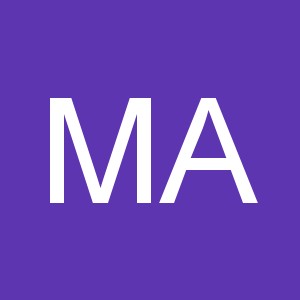
makala + Follow
Download Presentation
WATERSHED MANAGEMENT
An Image/Link below is provided (as is) to download presentation Download Policy: Content on the Website is provided to you AS IS for your information and personal use and may not be sold / licensed / shared on other websites without getting consent from its author. Content is provided to you AS IS for your information and personal use only. Download presentation by click this link. While downloading, if for some reason you are not able to download a presentation, the publisher may have deleted the file from their server. During download, if you can't get a presentation, the file might be deleted by the publisher.
Presentation Transcript
- WATERSHED MANAGEMENT Module 23, part A – Social Component
- Watershed management organization • Social Component • Ecological Component • Economic Component
- Watershed management structure • A strong watershed structure • uses sound science • facilitates communication and partnerships • fosters actions that are well planned and cost effective • stimulates actions and tracks results
- Watershed management organization • Social components • Organizational Set-up • Assessment • Planning • Implementation • Evaluation
- Social organization component The most common watershed management structure is a combination of both government and citizen directed groups. This type of organization does not usually have regulatory authority, but makes recommendations to local government agencies to ensure that management strategies selected by a diverse group of stakeholders is implemented.
- Organizational set-up • Goal of local watershed management organizations is to protect, preserve, restore natural resources through • Assessment • Planning • Implementation • Evaluation • The core of the process for achieving these goals is to build a watershed partnership
- Build a partnership • Recruit a diverse group of stakeholders who are affected by and who benefit from the watershed. This includes, but is not limited too: • Local government officials • Residents • Scientists • Businesses • Nonprofit agencies • State agencies • Federal agencies • Non-residents and concerned citizens
- Recruit a multi-disciplinary group to serve • Publicize the watershed organization to encourage citizen participation • Call or write to area businesses (e.g. Chamber of Commerce source) to solicit representatives to serve on the planning committee • Invite local, state, federal government agencies to share personnel who can provide technical advice • Encourage area schools and universities to participate
- Establish a citizen’s advisory committee • A diverse group of stakeholders from public and private sector • Has authority to develop and implement a plan • Provides recommendations to a decision-making body (e. g., county board, city council, nonprofit board, local grass roots authority) • Provides media relations to increase watershed awareness (e.g., press releases) • Coordinates programs to engage watershed volunteers (i.e., clean-ups, monitoring, fundraising, etc.)
- Establish a technical advisory committee • A group usually of scientific professionals including public agency staff with expertise in scientific matters associated with watershed management • Interprets scientific data for the watershed management organization • Assists with evaluation of monitoring data and monitoring needs • Provides assessments and coordination of approved implementation projects
- Joint Powers Agreement • Government plays an essential role especially when the watershed extends over more than one political jurisdiction • Government often provides financial and technical resources necessary for a watershed management organization to sustain themselves • Joint powers agreements (political agreement) help promote better coordination and sharing of data, staff, stakeholders, and the planning and implementation processes
- Organizational set-up • Goal of local watershed management organizations is to protect, preserve, restore natural resources through • Assessment – What is happening in the watershed? • Planning • Implementation • Evaluation
- Assessment – What is happening in the watershed? • What conditions are bringing the organization together? • Is it a desire to protect an undisturbed resource? • Is it a threat to a valuable resource? • Is there a need to restore a lost resource? • To answer this the organization must document the ecological, biological, chemical, and physical conditions of the watershed
- Assessment – Document watershed conditions using sound science • Prepare a natural resource inventory • Analyze and summarize monitoring data • Interview people who have lived in the watershed for a long period and have them reflect on changes they have seen
- Assessment – Knowledge of watershed/ecological information leads to better decision-making • a resource in good condition requires prevention management techniques to protect it from any degradation • a resource in good to moderate condition, requires protection management techniques to help sustain the existing quality of the resource by preventing further degradation • a resource in moderate to poor condition, requires restoration management techniques to help it attain an acceptable level of quality by restoring the area from previous degradation
- What is a Natural Resource Assessment? • A method using the natural resource inventory data to rank and prioritize areas for preservation, protection, or restoration. • Varies community by community. • Eden Prairie, MN used their wetlands inventory to determine vegetative buffer widths along varying wetlands.
- Organizational set-up • Goal of local watershed management organizations is to protect, preserve, restore natural resources through • Assessment • Planning – What needs to be done? • Implementation • Evaluation
- Planning – What needs to be done? • A watershed plan is the document which specifies the goals, policies, and strategies for the watershed. • Goals – Statements that describe the desired future watershed condition toward which programs, activities, and decisions are directed. • Policies – The strategic steps, or intermediate ends, required to reach the watershed’s goals. • Strategies – The specific actions by which the community will achieve its goals
- Planning – Example Goals • In Minnesota, Carver County used guidelines established by state statute to develop a set of water management goals. Some of these goals included: • Protect, preserve, and manage natural surface and groundwater storage and retention systems • Effectively and efficiently manage public capital expenditures needed to correct flooding and water quality problems • Identify and plan for means to effectively protect and improve surface and groundwater quality • Protect and enhance fish and wildlife habitat and water recreational facilities
- Planning – Example Policies • Stormwater • Provide stormwater attenuation to minimize degradation of the water resources through a reduction in the amount and rate of surface water runoff from agricultural and urban land uses. • Wetlands • Manage and restore wetlands in the watershed to protect the values of wetland functions as determined from a wetland inventory and functional values analysis
- Planning – Example Strategies • Stormwater • Set an impervious surface cover cap in the subwatersheds. • Add X acres of wetlands in the watershed. • Wetlands • Complete a wetland inventory and assess the values of the wetland functions for each of the watersheds • Implement a buffer ordinance for wetlands based on level of priority
- Organizational set-up • Goal of local watershed management organizations is to protect, preserve, restore natural resources through • Assessment • Planning • Implementation – How do you get there? • Evaluation
- Implementation – How do you get there? • The Watershed Plan is the community’s guide for project implementation. It includes: • Strategies or the tasks that need to be done in order of priority. • Time Frame for tasks to be completed. • Capital Improvement Plan which provides estimates of the funding needs for each task.
- Implementation - Example
- Organizational set-up • Goal of local watershed management organizations is to protect, preserve, restore natural resources through • Assessment • Planning • Implementation • Evaluation – Did you make it?
- Evaluation - Did you make it? • Evaluation is the key to measuring success of the watershed plan and toward making appropriate adjustments. Evaluation is important in various components of the watershed management including: • administration • water quality monitoring • mid-course corrections • long-term maintenance
- Evaluation • Administration component includes evaluating and publicizing the interim measures of success such as measuring how well the watershed is managed, strategies are implemented, data is gathered, and monitoring is evaluated. This may be done by • Preparing progress reports • Public awareness presentations and newsletters • Number and result of projects completed • Evaluating data and distributing results • Recommending adjustments to the plan
- Evaluation • Water quality monitoring component is important for • assessing baseline conditions • detecting trends in ambient water quality • measuring the pollutant-removal efficiencies of bmps • demonstrating effectiveness of restoration measures • monitoring the long-term maintenance of controls
- Evaluation • Mid-course corrections should be built into the process to periodically review all aspects of strategies including: • indications from monitoring that the problem is not being solved • other problems are created that are more difficult to control • goal(s) are reached, but it is not effective enough to reach water quality goals • measurable objectives (pollutant load reductions, hydrologic controls, etc.) were not set correctly to solve the problem.
- Evaluation • Ensuring long-term maintenance is often the least discussed and most difficult. Regular on-going maintenance must be provide for to ensure success. • Maintenance programs should be self-supporting whenever possible. • Projects are more likely to succeed if supported by private sector and citizens • Demonstrating success to the public is important for ensuring support for needed local regulations
- Evaluation • Establish evaluation criteria to assess both outcomes and process • Conduct evaluations throughout the watershed management process, not just at the end • Information gathered during other phases of watershed management (assessment, planning, implementation) can be used as part of the evaluation process • Incorporate any recommendations or insights gained from evaluations into the process right away
- References • Center for Watershed Protection. 1998. Rapid Watershed Planning Handbook. Center for Watershed Protection. Ellicott City, Maryland. http://www.cwp.org. • Center for Watershed Protection. 1997. The Economics of Watershed Protection. Watershed Protection Techniques, Vol. 2, No. 4. Center for Watershed Protection, Ellicott City, Maryland. http://www.cwp.org. • Honachefsky, William B. 2000. Ecologically Based Municipal Land Use Planning. Lewis Publishers, Boca Raton, FL. 256 pp. • Know Your Watershed. Putting Together A Watershed Management Plan – A Guide for Watershed Partners. Conservation Technology Information Center, W. Lafayette, IN. http://www.ctic.purdue.edu/KYW/Brochures/PutTogether.html • Ministry of Environment and Energy and Ministry of Natural Resources. 1993. Water Management on a Watershed Basis: Implementing an Ecosystem Approach. Ministry of Environment and Energy and Ministry of Natural Resources, Ontario, Canada. 32 pp. http://www.ene.gov.on.ca/programs/3109e.pdf. • Minnesota Department of Natural Resources. 2004. A Quick Guide to Using Natural Resource Information. Minnesota Department of Natural Resources, St. Paul, MN. www.dnr.state.mn.us. • Terrene Institute. 1996. A Watershed Approach to Urban Runoff – Handbook for Decisionmakers. Terrene Institute, Inc. Alexandria, VA. 115 pp. (Terrene Institute is no longer in operation – see http://www.enviroscapes.com/images/communit.JPG for a poster concept). • U.S. Environmental Protection Agency. 1997. Top 10 Watershed Lessons Learned. National Center for Environmental Publications and Information. 800-490-9198. http://www.epa.gov/owow/lessons/lessonspdfs/top10.pdf.
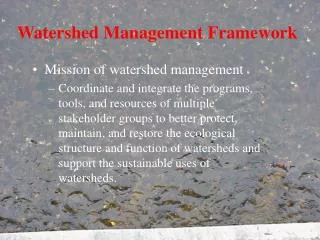
Watershed Management Framework
Watershed Management Framework. Mission of watershed management
856 views • 40 slides

Integrated Watershed Management Programme
Integrated Watershed Management Programme. State Level Nodal Agency Uttarakhand WMD , Dehradun . Progress . Watershed Management Directorate nominated as the State Level Nodal Agency (SLNA) as per the Common Guidelines vide G.O. No. 591/2008/XIII-II/51(5)/2005 dt. 11.09.2008.
847 views • 14 slides

Watershed Management Planning
1.21k views • 42 slides

MSc In Watershed Management
MSc In Watershed Management. MSc in Watershed Management. Complementary Projects. Minor Field (6 units) - the students in consultation with the Advising Committee, should enroll 3 courses representing his chosen minor fields. Silviculture
410 views • 13 slides
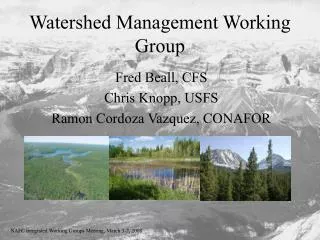
Watershed Management Working Group
Watershed Management Working Group. Fred Beall, CFS Chris Knopp, USFS Ramon Cordoza Vazquez, CONAFOR. History. BOA meeting in Oct. 2001 requested a scoping paper on watershed management issues Commissioners approved creation of Watershed Management Working Group in Oct. 2002
275 views • 6 slides

WATERSHED MANAGEMENT
WATERSHED MANAGEMENT. WMA 510 Dr. J.A. Awomeso , Dr O.Z. Ojekunle , Dr. G.O. Oluwasanya Dept of Water Res. Magt . & Agromet UNAAB. Abeokuta. Ogun State Nigeria oojekunle@yahoo.com. WATERSHED MANEGEMENT . WMA 510. Introduction.
18k views • 72 slides
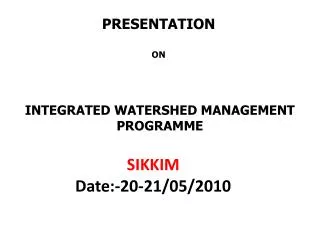
INTEGRATED WATERSHED MANAGEMENT PROGRAMME
PRESENTATION ON . INTEGRATED WATERSHED MANAGEMENT PROGRAMME. SIKKIM Date:- 20-21/05/2010. Details of Projects Sanction During The Year 2009-10. Status of Implementation of Projects During The Year 2009-10. Status of Implementation of Projects During The Year 2009-10.
944 views • 15 slides

Collaboration in Watershed Management
Collaboration in Watershed Management. Mark Shea - Watershed Planning - Colorado Springs Utilities. Colorado Springs Utilities Who We Are. Four-service utility provider Electric, natural gas, water, wastewater Over 650,000 customers Local government oversight
228 views • 7 slides
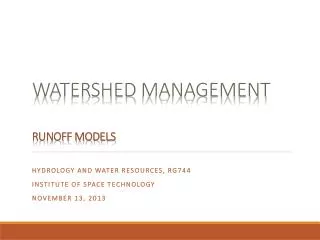
Watershed Management Runoff models
Watershed Management Runoff models. Hydrology and Water Resources, RG744 Institute of Space Technology November 13, 2013. Runoff models. Peak runoff models Provide only the estimates of peak discharge from the watershed Continuous runoff models
1.32k views • 73 slides
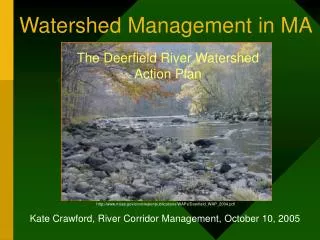
Watershed Management in MA
Watershed Management in MA. The Deerfield River Watershed Action Plan. http://www.mass.gov/envir/water/publications/WAPs/Deerfield_WAP_2004.pdf. Kate Crawford, River Corridor Management, October 10, 2005. MA River Management. Watershed-scale management approach Emphasis on: Water quality
422 views • 14 slides
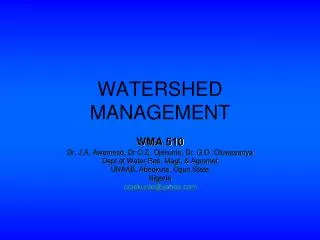
WATERSHED MANAGEMENT
WATERSHED MANAGEMENT. WMA 510 Dr. J.A. Awomeso , Dr O.Z. Ojekunle , Dr. G.O. Oluwasanya Dept of Water Res. Magt . & Agromet UNAAB. Abeokuta. Ogun State Nigeria oojekunle@yahoo.com. COURSE CODE : WMA 510 COURSE TITLE : Watershed Management COURSE UNITS : 3 Units
1.89k views • 77 slides
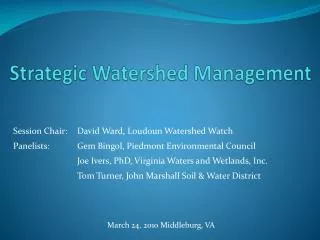
Strategic Watershed Management
Strategic Watershed Management. Session Chair: David Ward, Loudoun Watershed Watch Panelists: Gem Bingol, Piedmont Environmental Council Joe Ivers, PhD, Virginia Waters and Wetlands, Inc. Tom Turner, John Marshall Soil & Water District. March 24, 2010 Middleburg, VA. A Watershed Approach.
342 views • 5 slides

Watershed Management Wake County
Watershed Management Wake County. Monitoring Drivers. 2003 Watershed Plan Pollutant loads & trends Assess programs Develop strategies and projects Regulatory compliance. Monitoring Points. Falls watershed in 2007 Other watersheds 2009. Watershed Monitoring Parameters.
504 views • 14 slides

Watershed Management institutional aspect
Watershed Management institutional aspect. Land husbandry in dry prone area Module 556. By - Zeremariam G. Mosazghi 21/3/00. What is watershed. Watershed. Land area from which rainfall or snowmelt drains into single water body.
478 views • 11 slides

Forest Watershed Management
Forest Watershed Management. Course Objective:
1.29k views • 45 slides

WATERSHED MANAGEMENT
WATERSHED MANAGEMENT. Muhammad Tayyab Nauman 2004- ag -1411 7 th Semester Department of Agronomy. Watershed. The area that drains into a river or other body of water. Actions in one part of a watershed will often have an impact throughout the watershed. Watersheds & Watershed Management.
1.38k views • 27 slides

Watershed Management What is a watershed?
Watershed Management What is a watershed? Line of separation between two catchments (UK) [Chambers dictionary] Watershed (USA) = Basin (USA) = Catchment (UK) [US usage is most common overseas] Frequently (incorrectly) used to refer to upper or steep part of watershed
951 views • 39 slides

WATERSHED MANAGEMENT
WATERSHED MANAGEMENT. Module 23, part A – Social Component. Watershed management organization. Social Component Ecological Component Economic Component. Watershed management structure . A strong watershed structure uses sound science facilitates communication and partnerships
971 views • 32 slides

Integrated Watershed Management Programme
Watershed Development Department Government of Karnataka. Integrated Watershed Management Programme. NET PLANNING PROCESS. H.G Shivananda Murthy IFS Commissioner. Planning. Plan is the document, detailed proposal for doing or achieving something
524 views • 23 slides

Collaborative Watershed Management
Collaborative Watershed Management. Collaborative Watershed Management. Kansas NPS Management Plan. 1989 – Approved Policy, Implementation, Funding Short Term Goals, Long Term Goals, Action Plans First Overhaul – 2000 Broad Goals, Objectives, Strategies Second Overhaul – 2010-2011
309 views • 10 slides






















